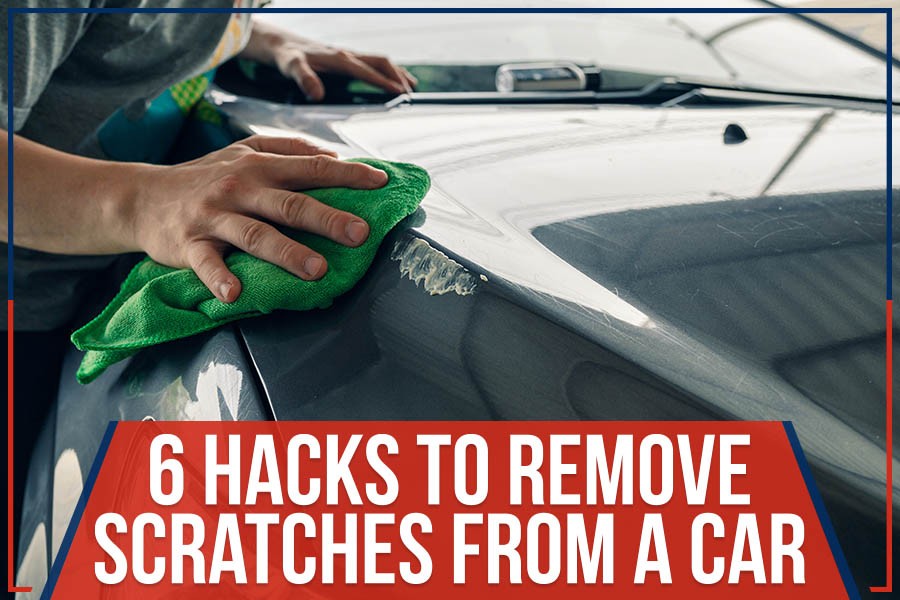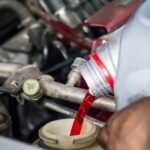Scratches on your car are frustratingly common. Whether it’s a stray shopping cart in a parking lot, a bush too close to the road, or just everyday wear and tear, these blemishes can detract from your vehicle’s appearance and potentially lower its resale value. The good news is that not all scratches require a trip to the body shop. Many minor scratches can be addressed at home with simple DIY methods, while deeper damage might necessitate professional intervention. This guide will walk you through several effective techniques to remove scratches from your car, helping you decide the best approach for your specific situation.
 Close up of hand using toothpaste to remove scratch from car paint.
Close up of hand using toothpaste to remove scratch from car paint.
DIY Car Scratch Removal Methods
For superficial scratches that haven’t penetrated the clear coat too deeply, you can often achieve impressive results using household items. These methods are cost-effective and can save you time and money.
1. Toothpaste Trick
Believe it or not, toothpaste can act as a mild abrasive to buff out light scratches. The key is to use a non-gel toothpaste.
How to use toothpaste for scratch removal:
- Ensure the area around the scratch is clean and dry.
- Apply a small amount of non-gel toothpaste to a soft, clean microfiber cloth.
- Gently rub the toothpaste onto the scratch using circular motions. Apply light pressure.
- Rinse the area with water to remove toothpaste residue.
- Dry the area with a clean microfiber cloth.
- Inspect the scratch. You may need to repeat the process for slightly deeper scratches.
This method works best on very light surface scratches and swirl marks.
2. Clear Nail Polish for Deep Scratches
For deeper scratches that have gone through the clear coat but haven’t reached the metal, clear nail polish can act as a sealant to prevent rust and make the scratch less noticeable. This is a temporary fix but can be helpful in protecting the underlying paint layers.
How to use nail polish for scratch removal:
- Clean and dry the scratched area thoroughly.
- Apply a thin layer of clear nail polish directly into the scratch. Try to only fill the scratch and avoid applying polish to the surrounding paint.
- Allow the nail polish to dry completely and harden. This may take a few hours.
- Once fully dry, use a very fine polishing compound or rubbing compound and a clean cloth to gently buff away any excess nail polish, leveling it with the surrounding paint. Be careful not to scratch the surrounding area further.
This method is best for deeper scratches to protect the exposed layers and improve appearance, but professional repair is recommended for a permanent fix.
3. Baking Soda Paste for Minor Blemishes
Baking soda, when mixed with water, creates a mild abrasive paste that can help to buff out minor scratches and scuff marks.
How to use baking soda paste for scratch removal:
- Mix baking soda and water to create a paste with a slightly thick consistency. A 1:1 ratio is usually a good starting point.
- Apply the baking soda paste to a clean, damp microfiber cloth.
- Gently rub the paste onto the scratch using circular motions.
- Rinse the area thoroughly with water to remove all baking soda residue.
- Dry the area with a clean microfiber cloth and assess the results. Repeat if necessary.
Baking soda paste is effective for light scratches and may be less abrasive than toothpaste.
4. Vinegar Solution for Surface Marks
While not as abrasive as other methods, a simple vinegar solution can help clean the scratch and potentially minimize the appearance of very light surface marks or residue causing the scratch to look worse.
How to use vinegar solution for scratch removal:
- Mix equal parts white vinegar and water in a clean bowl or spray bottle.
- Dip a clean microfiber cloth into the vinegar solution, or spray the solution directly onto the scratched area.
- Gently rub the area with the cloth.
- Rinse the area with clean water and dry with a clean microfiber cloth.
Vinegar is a mild cleaning agent and might be helpful for removing grime that accentuates scratches, but it’s less effective for actually buffing out scratches themselves.
When to Consider Commercial Scratch Removers
For slightly more stubborn scratches that DIY methods can’t fully eliminate, commercial scratch removal products offer a more targeted solution. These products are specifically formulated to remove scratches from car paint and often contain polishing compounds and fillers.
5. Using Commercial Car Scratch Removal Kits
Commercial scratch removal kits are widely available at auto parts stores and online. They typically include a scratch remover compound, applicator pads, and microfiber cloths.
How to use a commercial scratch removal kit:
- Read and carefully follow the instructions provided with the specific product kit.
- Generally, you will apply a small amount of the scratch remover compound to an applicator pad.
- Rub the compound onto the scratch using firm, even pressure and often in circular or back-and-forth motions as directed.
- Wipe away excess product with a clean microfiber cloth.
- Some kits may include a polishing compound or wax for a final finishing step.
Choose reputable brands and avoid extremely cheap kits as they may contain harsh abrasives that can damage your car’s paint.
When Professional Scratch Repair is Necessary
For deep scratches that penetrate beyond the clear coat and into the base coat or primer, or for larger areas of damage, professional scratch repair is the best course of action. Trying to fix deep scratches yourself can lead to further damage or an uneven finish.
6. Seeking Professional Car Scratch Repair Services
Professional auto body shops have the expertise, tools, and materials to properly repair deep car scratches. They can perform services such as:
- Sanding and Refinishing: Professionals can carefully sand down the scratched area, blend the surrounding paint, and reapply clear coat and color-matched paint for a seamless repair.
- Color Matching: They have the technology to precisely match your car’s paint color, ensuring the repaired area blends perfectly with the rest of the vehicle.
- Warranty: Professional repairs often come with a warranty, giving you peace of mind.
While professional repair is more expensive than DIY methods, it provides the highest quality and most durable solution, especially for significant scratches. It’s also a good option if you are concerned about maintaining your car’s resale value.
Ultimately, deciding how to remove scratches from your car depends on the severity of the damage and your comfort level with DIY solutions. For minor scratches, home remedies and commercial scratch removers can be effective. However, for deeper, more extensive scratches, entrusting the repair to professionals will ensure the best possible outcome and protect your vehicle’s finish in the long run.
